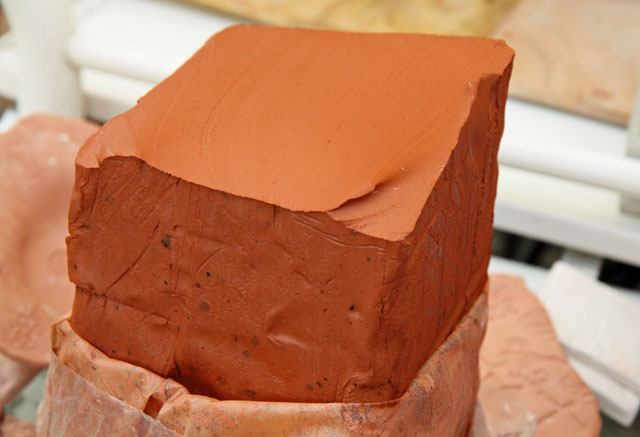Hands-On Pottery Lesson For Kids – Part 1 Beginning Handbuilding
Hands-On Handbuilding Lesson For Kids
Please reference Hands-On Pottery Lesson Plan For Kids: Introduction.
Work Surface
If you are not teaching in a pottery studio with a large wood-topped hand building table, you can use tables covered with plywood boards. I’ve used long narrow boards (about 12” – 14” wide) that worked pretty well (someone will have to hold the board while you are rolling out the clay).
Time
Allow two to three hours, and remember that you will need time to clean up.
Project Suggestions For Rolled Out Clay (sometimes called slab building)
Wall plaques
Ornaments
Draped bowls
Pendants
Cups or Vases
I am not skilled (at all) in sculpture, so I won’t be covering this topic. However, here are some more ideas from YouTube on how to teach kids to work with clay, including sculpture.
(The link to the playlist is: http://www.youtube.com/playlist?list=PLik0ME7bTBFPPwMpEe08ePoe21Fuz9UeP)
A Few More Ideas
• Use paper towel tubes for forming cups or vases.
• For a bowl or serving dish, crumple newspaper into a long “snake” and form into a circle. Make the inside diameter the same as the bowl you are making. “Slump” the slab of clay (after you have finished with the texture) into the middle of the newspaper circle and drape the rim over the newspaper snake as you like. Let dry in the newspaper mold until at least leather-hard.
• Create ornaments for family members – the child can press in his or her handprint, fingerprints, etc., then carve in their name and the year.
If you are looking for more handbuilding projects for kids and suggestions for air-dry clay, please see this post: Clay projects for kids: Pinch pots, clay beads and maybe some sculpture?
Recommended Tools and Supplies
Basic Needs
Old clothes, large t-shirts, or aprons to protect clothing
Large wooden tables, or plywood boards on tables (each child needs at least 2-1/2 to 3 feet of space)
Clay (soft stoneware clay, low-fire clay or air-dry clay – 1/2 pound to 1 pound per child)
Wooden rolling pins (never to be used for food)
Thickness strips (square dowels found at hobby or craft store, 3/8” thick)
Texture tools (sea shells, rocks, leaves, rubber stamps, anything that can be pressed into clay)
Hole-cutters (clay hole cutters or skewers, straws, drill bits, etc.)
Optional
Cookie cutters (in different sizes and shapes for pendants and ornaments)
Wooden clay shaping tools
Plaster molds for draping or slumping
Paper towel tubes or newspaper for forming, draping and/or slumping
Kemper High-Temp stamen wire for hangars (you’ll need wire cutters, too)
Water spritzers or sprayers for too-dry clay
Lesson Materials
Pottery Terms & Definitions Handout PDF
Clay tiles or small forms in the various stages for demonstration purposes:
• Leather-hard
• Bone-dry
• Bisque Fired
• Glazed
The Lesson
I recommend you don’t start until you have the work surface prepped , the clothing protected, and tools and materials ready. Everyone should wash their hands before working with the clay.
1. Go through the Pottery Terms & Definitions Handout PDF while handing around the clay tiles in various stages (see above). Allow time for questions.
2. Go through the following essentials:
- Wash your hands before and after working with clay.
- Do not eat or drink while working with the clay. Keep it away from your mouth.
- The dust is not good for you. Try to keep the clay in your immediate work area and clean up with old damp towels as soon as you are done. Use a wet mop instead of a vacuum cleaner. (If you are outside, spray everything down.)
- The more the clay is handled, the more it will dry out. Spritz it with water (or start over with new clay) if it gets too dry.
- The thickness of the clay should be kept as even as possible for proper drying and firing. I suggest aiming for about 3/8” thick for beginners (don’t press down too hard with a texture tool, or roll one part of the clay out thinner than another).
- Smooth out rough edges, carve names or initials, and cut needed holes when the clay is almost leather-hard
3. Demonstrate wedging and explain its purpose (see Pottery Terms Handout). I recommend allowing the older kids to try it if you have the time.
4. Roll out the clay for the younger children, using the thickness strips as guides for the rolling pin. The older kids will probably want to roll their own clay. Show them how to flatten the wedged ball of clay with their hands, then roll out from the center outwards.
5. You can let them make what they like, or you can have them all make the same thing. Provide as many or as few tools as you like, give some basic instructions, then step back and let them create!
Conclusion
Explain that the clay creations will have to dry for several days before firing. Allow enough time for drying and firing before scheduling Lesson 2, Brush-On Glazing.
Thank you for visiting Cotton Ridge Homeschool! If you have any suggestions or questions about working with kids and pottery, please comment below!
Text Copyright 2012 Kathryn Depew, Images Copyright 2012 Erica McNeese, Used by Permission.
Related articles




Leave a Reply